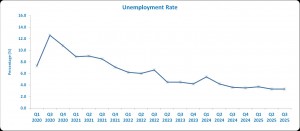October 1, 2025
Labour Force Expansion and Participation
In July 2025, Jamaica’s labour force grew to 1,490,300 individuals, marking an increase of 28,700 persons compared to July 2024. This growth was primarily driven by males, who accounted for 66.6% of the increase. The overall labour force participation rate rose to 69.1%, with male participation at 75.0% and female participation at 63.4%.
Employment Growth
The number of employed persons rose by 32,100 to 1,441,100, a 2.3% increase year-over-year. Male employment saw a stronger rise (3.4%) than female employment (1.0%). Notably, 67.6% of the employed were in the prime working age group (25–54 years), which contributed 42.1% of the employment increase. Youth employment also grew significantly by 7.2% (12,200 individuals).
Underemployment declined, with 25,400 persons working part-time while seeking more hours—5,400 fewer than in July 2024.
Occupational and Industry Trends
The ‘Managers’ occupational group experienced the largest employment increase, adding 10,300 persons (11.4%), with female managers growing by 14.6%. The ‘Services and Sales Workers’ group followed with a 7,300-person increase (2.2%), driven by male employment growth of 11.2%.
By industry, the most notable gains were in ‘Wholesale and Retail Trade; Repair of Motor Vehicles and Motorcycles’, which added 8,800 jobs, all held by males. The ‘Manufacturing’ sector saw the second-largest increase (7,600 jobs), while the ‘Arts, Entertainment, Recreation and Other Services’ sector led female employment growth with 5,700 additional jobs.
Unemployment Decline
Unemployment fell by 3,400 persons to 49,200, a 6.5% decrease. The prime working age group saw the largest drop (11.4%). Male unemployment declined sharply by 24.4%, while female unemployment rose by 2,800, slightly offsetting the overall decline. The national unemployment rate dropped to 3.3%, with males at 2.4% and females at 4.4%.
Reduction in Persons Outside the Labour Force
The number of individuals outside the labour force decreased by 28,700 to 665,500, driven mainly by a 19,100-person decline among males. Females outside the labour force also declined by 9,600. The number of prime working age individuals outside the labour force fell by 8,000, and youth non-participation dropped by 11,700.

Disclaimer:
Analyst Certification -The views expressed in this research report accurately reflect the personal views of Mayberry Investments Limited Research Department about those issuer (s) or securities as at the date of this report. Each research analyst (s) also certify that no part of their compensation was, is, or will be, directly or indirectly, related to the specific recommendation(s) or view (s) expressed by that research analyst in this research report.
Company Disclosure -The information contained herein has been obtained from sources believed to be reliable, however its accuracy and completeness cannot be guaranteed. You are hereby notified that any disclosure, copying, distribution or taking any action in reliance on the contents of this information is strictly prohibited and may be unlawful. Mayberry may effect transactions or have positions in securities mentioned herein. In addition, employees of Mayberry may have positions and effect transactions in the securities mentioned herein.
